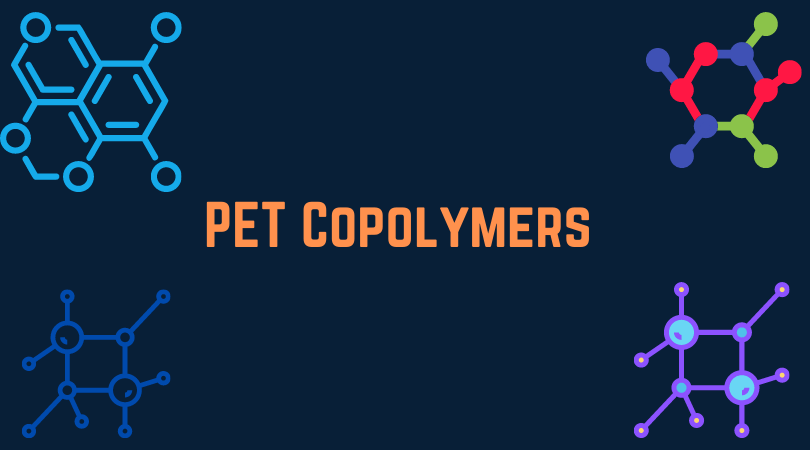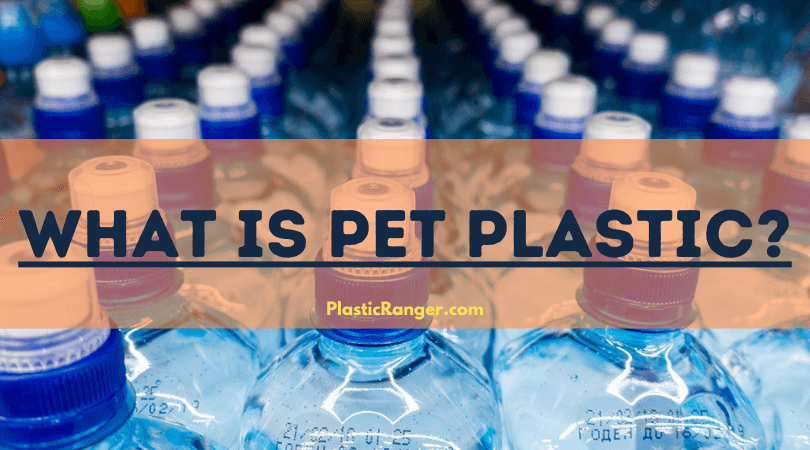What is PET Plastic?
Polyethylene terephthalate, better known as PET Plastic (also sometimes as PETE ), is the most used thermoplastics globally in various textiles, films, electronics, packaging, automobiles, etc. The biggest utilizer of PET is the textile industry, in which thermoplastic is mainly known by the name Polyester. It has a fantastic set of properties, like chemical, mechanical, thermal resistance, and dimensional stability. Making it very attractive plastic for manufacturers.
PET structure is made by combining ethylene glycol and terephthalic acid through condensation. This results in repeating units of ethylene terephthalate, which form the polymer. It is semi-crystalline in nature and colorless.
Some essential properties include water resistance and toughness (the strength-to-weight ratio is impressive). The material is virtually shatterproof, which improves its applicability by many nautches.
PET plastic is also highly recyclable (which we’ll discuss later in the article ) and has the number “1” as its recycling symbol.
According to many worldwide reports, PET, with an annual production of 56 metric tons, is the most used thermoplastic in the world.
The textile industry consumes approximately 60% of that; other major consumers include the packaging and bottling industry with 30%.
PET Copolymers

PET or PETE is originally a homopolymer but can be modified to produce copolymers ( polyethylene terephthalate glycol-modified ) depending on the application.
The commonly used modifiers to produce PETG are cyclohexane dimethanol (CHDM) and isophthalic acid.
These polymers predominantly react with crystallization, changing or lowering the polymer’s temperature.
PET Characteristics
PET or polyethylene terephthalate has many consequential properties. Let’s talk about them.
Chemical Resistance: PET has a significant amount of resistance toward water, food, and natural causes like bacteria, fungi, etc. That makes it compatible with food packaging applications.
Transmittance: It is naturally transparent. However, it doesn’t look exciting compared to other highly transparent polymers like Polycarbonate and Acrylic. These polymers should be used instead of PET if high transparency is required.
Shatterproof: PET plastic is solid and robust. PET density is 1.38 g/cm³, and It is virtually shatterproof and thus used as an alternative to glass.
Polyethylene terephthalate is originally a thermoplastic, and it is decided by how it reacts to heat. However, there are many variants of polyesters that are considered thermosets.
The significant difference between thermoplastics and thermosets can be attributed to how they react to heat. Thermoplastic melts at its melting point ( 260°C for polyester ).
When it needs to be processed in injection molding, the primary benefit of any thermoplastics is that when it melts, the liquid form can be cooled and reheated without large degradation.
On the contrary, thermosets can only be burned once as the first heating changes their chemical nature that cannot be reversed.
Once their chemical nature is changed, any additional heating will burn the polymer—That’s one of the main reasons for thermosets being poor candidates for recycling.
Faacinating Read – What is PETG Material? | The Definitive Guide
| Property | Value |
| Mechanical Properties | |
| Coefficient of friction | 0.2 – 0.4 |
| Poisson’s ratio | 0.37-0.44 |
| Tensile modulus ( GPa ) | 2 – 4 |
| Tensile strength ( MPa ) |
80, (for biax film 190 – 260)
|
| Hardness – Rockwell | M94-101 |
| Izod impact strength ( J.m-1 ) | 13 – 35 |
| Physical Properties | |
| Limiting oxygen index | 21% |
| Refractive index | 1.58 – 1.64 |
| Water absorption – equilibrium | <07% |
|
Water absorption – over 24 hours
| |
| UV Resistance | Good |
| Flammability |
Self-Estrinugusing
|
| Refractive index | 1.58 – 1.64 |
| Density ( g.cm-3 ) | 1.3 – 1.4 |
| Thermal Properties | |
| Working temperature ( °C ) | 115-170 |
| Specific heat ( J.K-1.kg-1 ) | 1200 – 1350 |
| Thermal conductivity ( W.m-1.K-1 ) | 0.15 – 0.4 @ 23 |
| Heat-deflection temperature – 0.45 MPa ( °C ) | 115 |
| Heat-deflection temperature – 1.8 MPa ( °C ) | 80 |
| Coefficient of thermal expansion ( x10-6 K-1 ) | 20 – 80 |
History
John Rex Whinfield, James Tennant Dickson, and their employer, the Calico Printers’ Association based in Manchester, England, patented PET in 1941.
Concurrently, across the ocean, E. I. DuPont de Nemours, situated in Delaware, United States, began to use the trademark Mylar for the first time in June 1951 and anticipates receiving registration for it by 1952.
This name will become the most recognized title for the polyester film, with DuPont Teijin Films poised to become its trademark owner.
Meanwhile, in the Soviet Union, the manufacturing of PET is happening for the first time in the labs of the Institute of High-Molecular Compounds of the USSR Academy of Sciences in 1949. The name, “Lavsan,” cleverly conceals an acronym symbolizing the long-form title of the research institute in Russian.
Fast-forwarding to 1973, Nathaniel Wyeth is on the verge of creating the PET bottle, a groundbreaking invention that DuPont is set to patent.
The subtle intertwining of these narrative threads is crafting the tale of PET’s global evolution, a material destined to revolutionize the world of manufacturing and consumer goods.
How is PET Made?

Polyethylene terephthalate, in the current world of chemistry, arises from the unification of ethylene glycol, commonly known as “MEG” or monoethylene glycol, and dimethyl terephthalate (DMT) (C6H4(CO2CH3)2).
However, it’s primarily terephthalic acid, recognized in the industry as “PTA” or purified terephthalic acid.
As it stood in 2022, the sources of these components are interestingly diverse: ethylene glycol is derived from ethene found in natural gas, while p-xylene from crude oil forms terephthalic acid.
In a captivating dance of chemistry, a catalyst, usually an antimony or titanium compound, aids the reaction, with a phosphite added for stability.
Lastly, a dash of a bluing agent, such as cobalt salt, is introduced to counteract any potential yellowing.
A fascinating process unfolds when creating polyethylene terephthalate through the dimethyl terephthalate (DMT) process.
Here, DMT combines with an excess of MEG, undergoing transesterification in the melt at temperatures ranging from 150–200 °C in the presence of a primary catalyst.
The systematic removal of methanol (CH3OH) by distillation forces the reaction to proceed, while surplus MEG gets distilled at a higher temperature under the watchful eye of a vacuum.
A second transesterification at 270–280 °C follows, with MEG continually filtered. The entire process is a seamless sequence of chemical reactions outlined in two steps.
However, an alternate pathway emerges from the terephthalic acid (PTA) process. MEG and PTA directly engage in esterification under moderate pressure (2.7–5.5 bar) and high temperature (220–260 °C).
The elimination of water, a by-product of the reaction, is meticulously managed by continuous distillation.
Thus, these intricate procedures, each with unique nuances, paint a fascinating portrait of the science and art of chemical production.
Processing Conditions for PET Plastic

PET is perfectly compatible with injection molding, Blow Molding, Extrusion Molding, and 3D Printing processes. The general use for PET plastic is extruding produce films and sheets.
Drying polyethylene terephthalate up to 2-3 hours before processing is advisable.
| Injection Molding | Blow Molding | Extrusion Molding | 3D Printing |
| Melt temperature – 280-310°C. | Melt temperature – 200 to 245°C | Extrusion temperature – 270-290°C |
Advised temperature – 40 and 260°C
|
| Mold temperature: 140-160°C | Mold temperature – 10-50°C | NA |
Bed Temperature – 100°C
|
| Most preferred for transparent applications. | Blow Molding is commonly utilized for manufacturing transparent bottles. | PET can produce films and sheets, which can be thermoformed later. |
Most preferred manufacturing products with complicated geometries like toys, gifts, and novelty items.
|
|
The recommended screw L/D ratio is 18-22.
| NA | Extrusion speed around 100 RPM |
Retraction speed should be slow at 30mm/s or less.
|
Applications
- Because PET has phenomenal water and barrier-resistive properties, it is often used to manufacture plastic bottles for mineral water, alcohol, and carbonated drinks.
- Non-Oriented PET is often thermoformed to produce packaging trays, plastic cups, and blisters.
- Its Rigidness and fabulous mechanical strength make it a prime choice for manufacturing tapes.
- A range of physical properties and chemical inoperativeness make it compatible with food packaging applications.
- Polyester is one of the most common polymers in the textile industry.
- Packaging also depends on PET for microwave containers, rigid jars, transparent films, sheets, etc.
Advantages and Disadvantages of PET

Advantages
- PET possesses a high strength-to-weight ratio (a rare quality found). Thus, easy and inexpensive to transport.
- It is available in abundance and is inexpensive compared to other thermoplastics.
- It is moisture resistant.
- It shows fantastic electrical insulating properties.
- PET is smack and fracture-proof, making it an excellent alternative to glass in many applications.
- It exhibits high resistance to organic matter and water, which can become advantageous or a nuisance depending on the application.
- PET is approved to be safe with food and beverages. Agencies like FDA, Health Canada, and EFSA have given it a free flag.
- Polyethylene terephthalate can be recycled. Recycling includes a series of washing processes; after that, it can be reused.
- It is transparent to microwave radiation.
- Compared to its closest competitor, Polybutylene terephthalate (PBT), PET shows higher heat distortion temperature (HDT).
Disadvantages
Polyethylene terephthalate has great qualities, and the positives obviously outweigh the negatives, but we should still look at them.
- PET is not biodegradable
- PET is somewhat vulnerable to oxidation (But nothing is rock solid proof about this).
Largest PET Manufacturers Globally
| Rank | Company Name | Headquarters | Specialization | Strengths |
| 1 | Indorama Ventures | Bangkok, Thailand | World’s largest producer of PET resin |
Global presence, integrated supply chain, continuous innovation
|
| 2 | M&G Group | Tortona, Italy | PET resins and engineering plastics |
High-quality products, strong European market foothold
|
| 3 | Jiangsu Sanfangxiang Group | Jiangyin, China | Leading manufacturer of PET resin in China |
Scale, market dominance in China, R&D focus
|
| 4 | DAK Americas | Charlotte, USA | Major PET resin producer in the Americas |
Robust technology, sustainability focus, use of recycled PET
|
| 5 | Far Eastern New Century (FENC) | Taipei, Taiwan | Diverse offerings including PET |
Innovation, quality, focus on green materials
|
Recycling of PET Plastic and its Effects on the Environment

Polyethylene Terephthalate plastic recycling has direct and indirect environmental implications that can be categorized into resource conservation, energy efficiency, and pollution control. Starting with resource conservation, recycled PET (rPET) reduces the need for virgin plastic production, conserving petroleum resources.
It has been estimated that the recycling of a ton of PET saves approximately 48 cubic meters of landfill space. Energy efficiency is another dimension to consider.
PET recycling generally consumes less energy compared to producing virgin PET. A study suggests that the energy needed to recycle PET is approximately 50% less than that required for its virgin production.
This difference can have a significant environmental impact when scaled. It leads to reduced greenhouse gas emissions and a smaller carbon footprint.
Pollution control is also enhanced through PET recycling. When PET plastic isn’t recycled, it often ends up in landfills or the ocean, where it takes hundreds of years to degrade.
Through recycling, the risk of PET contributing to landfill accumulation and marine pollution is substantially mitigated. However, the recycling process itself can have environmental drawbacks.
Chemical recycling processes may produce toxic substances, though advancements are being made to mitigate this.
Also, not all PET plastic is recyclable due to contamination or mixed materials, leading to sorting and purification challenges.
To sum up, while PET recycling has its challenges and limitations, the overall net effect leans towards a more sustainable environmental balance.
The advancement of cleaner and more efficient recycling technologies could tip the scales in favor of environmental sustainability.
Interesting Read – What is Polypropylene Material? | The Ultimate Guide
FAQs
Below are the frequently asked questions on PET polymer. Let’s dig deep to know more.
Which Plastic material is better? PET or Polycarbonate?
Both PC and PET have their pros and cons. Polycarbonate has better catch resistance and is easier to wash, but PET resin is cheaper than polycarbonate; however, that doesn’t necessarily translate into good profits as equipment to process PET bottles are more expensive.
Which Plastic material is better? PET or Polypropylene?
Both plastic materials are heavily utilized in the plastics processing industry, and they have advantages and disadvantages. Talking about PET, its products have slightly better impact resistance than products made from polypropylene. In addition, PET containers are often regarded as best for maintaining the taste and aroma of food, thanks to their great oxygen barrier properties. On the other hand, PP containers fare better in moisture, alcohol, and chemical resistance.
Why is PET easier to recycle than PP?
PET is easier to recycle than PP because its polymer chain breaks down at a relatively low temperature. As a result, there is minimal degradation of the polymer chain during the recycling process. On the other hand, the degradation of PP during the recycling process is more fierce, resulting in more difficulties in recycling.
At what temperature do plastic bottles melt?
PET bottles usually melt at a temperature of 255 degrees Celsius (491 degrees Fahrenheit).
How many times PET bottles can be recycled?
New scientific studies conducted in the US show that PET and HDPE bottles have a significant market share in the American bottling industry and can be recycled at least 10 times.
Final Thoughts
In conclusion, Polyethylene Terephthalate (PET) is a remarkable material that has transformed the world of consumer goods. Its attributes, from durability to flexibility, combined with its recyclability, underline its pivotal role in today’s society.
However, managing its lifecycle responsibly is imperative to mitigate environmental impact, highlighting the importance of recycling and conscious consumption. Future advancements in PET production and disposal hold promise for a sustainable future.
Thanks for reading the article. Kindly comment on your thoughts and reviews in the comment box.
Have a fantastic day.
Quick Navigation


Can I know when antimony that is sometime found in PET Plastic is appeared i.e., at what temperature and duration in direct sunlight?
Ha ha ha …Write an article about how PET is in the blood streams of 80% of human kind:) I bet that will turn out great:)
It is what it is, Ask a relief, usage of PET is steadily decreasing worldwide bcoz of its severe effects on the environment.
Hi Friend,
Thanks for sharing this highly informative article on PET plastic.
My pleasure.
Great Write up!
Just wondering – would PET or PETG be good alternative materials for constructing a beehive?
PRO/CONS ?
To be honest, I think wood will be the best option for making a beehive, but PET or PETF will also work.
PET plastic was never explained this well.
Thanks